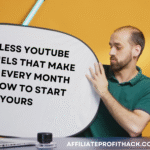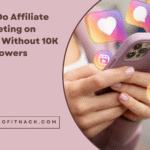Welcome to my article “How to Get More Organic Traffic Without Spending on Ads”.
Let’s be honest—spending money on ads can feel like tossing cash into a digital black hole, hoping for the best. But what if I told you there’s a way to drive tons of traffic to your website without draining your wallet? Yep, organic traffic is the golden ticket! It’s free, sustainable, and—when done right—it can bring in a steady stream of visitors who are actually interested in what you offer. No more playing the guessing game with ad budgets!
But here’s the catch: getting organic traffic isn’t about just throwing some keywords into your content and hoping Google rewards you. It takes a mix of smart SEO, high-quality content, and strategic promotion. Think of it like growing a garden—plant the right seeds (SEO), water it with valuable content, and let social media and backlinks shine some sunlight on it. Before you know it, your website will be blooming with visitors. In this guide, I’ll walk you through the best ways to attract organic traffic, boost your rankings, and keep your audience engaged—without spending a dime on ads. Let’s get started.
My Best Recommended & Proven Way to Make $100-$300 Daily – Watch This FREE Video to START >>>

Optimize Your Website for SEO
If your website isn’t optimized for search engines, it’s like throwing a party and forgetting to send out invitations. No matter how great your content is, if Google can’t find it, neither can your audience. The good news? SEO isn’t some mystical art that only tech wizards can master. With a few strategic tweaks, you can make your website more search-friendly and attract organic traffic without paying a single rupee.
On-Page SEO: Making Your Content Google-Friendly
Let’s start with the basics—on-page SEO. This is where you fine-tune individual pages to make them rank higher in search results. First, keywords matter, but don’t go stuffing them everywhere like a desperate salesman. Place them naturally in your titles, headings, and meta descriptions. Speaking of meta descriptions, don’t ignore them! A compelling meta description can be the difference between someone clicking on your site or scrolling past it faster than a skipped ad.
Next, your URL structure should be short, clean, and keyword-rich. No one wants to click on a link that looks like a math equation (e.g., yourwebsite.com/p=12345). Instead, opt for something descriptive like yourwebsite.com/best-seo-tips. Also, don’t forget internal linking—guide visitors to related content on your site to keep them engaged longer (and give search engines a little nudge about your site’s structure).
Technical SEO: Keeping Google Happy Behind the Scenes
Now, let’s talk about the less glamorous but equally important side of SEO—technical optimization. If your site loads slower than a dial-up connection from the 90s, visitors (and Google) won’t stick around. Use tools like Google PageSpeed Insights to check your speed and compress images to make your site load faster.
Mobile-friendliness is another biggie. With most people browsing on their phones, your site needs to be responsive. If users have to pinch and zoom just to read your content, they’ll bounce off faster than you can say “SEO.” And while we’re at it, set up an XML sitemap and a robots.txt file—think of them as roadmaps that help search engines crawl your site efficiently.
User Experience: Because SEO Isn’t Just About Search Engines
Even the best SEO strategy won’t work if visitors land on your site and immediately leave. Your website should be easy to navigate, with clear headings, a logical layout, and readable fonts (nobody wants to decode microscopic text). Also, break up long walls of text with bullet points, subheadings, and images. If people enjoy their experience on your site, they’ll stay longer—and Google will take notice.
In short, optimizing your website for SEO isn’t just about tricking search engines—it’s about creating a smooth, enjoyable experience for real humans. And when you do that, Google rewards you with higher rankings, more visibility, and a steady flow of organic traffic. Sounds like a win-win, right?
Create High-Quality, Valuable Content
If SEO is the engine that drives organic traffic, content is the fuel. You can have the fastest website in the world, perfectly optimized for search engines, but if your content is bland, outdated, or just plain useless, no one’s sticking around. Google doesn’t just rank sites based on technical factors—it prioritizes value. In other words, if your content doesn’t help, inform, or entertain your audience, it’s as good as invisible.
Write for Humans, Optimize for Search Engines
A common mistake? Writing for search engines instead of people. Stuffing your content with awkwardly placed keywords might have worked in 2010, but Google is much smarter now. Instead of cramming in as many keywords as possible, focus on natural, engaging writing that actually answers users’ questions. Start by researching what your audience is searching for—tools like Google Keyword Planner, Ahrefs, and Ubersuggest can help you find relevant, low-competition keywords. Then, seamlessly integrate them into your content without making it sound forced.
Another trick? Answer common questions directly. Google loves featured snippets (those short answers that appear at the top of search results), and if your content is structured well—with clear subheadings, bullet points, and concise explanations—you increase your chances of landing that prime real estate.
My Best Recommended & Proven Way to Make $100-$300 Daily – Watch This FREE Video to START >>>
Go Beyond Basic Blog Posts
If your idea of content is just cranking out 500-word blog posts once a month, it’s time for a rethink. Long-form content (1,500+ words) tends to rank better because it covers topics in-depth and keeps users on your site longer. But don’t just write long articles for the sake of it—make sure they’re packed with useful information, actionable tips, and real insights.
Also, diversify your content. Not everyone wants to read a wall of text. Mix things up with:
- Infographics (great for summarizing complex data)
- Videos (Google often ranks YouTube content highly)
- Case studies (real-world proof builds credibility)
- Listicles and how-to guides (people love clear, structured content)
Repurposing content across different formats can also help you reach a wider audience. A blog post can become a LinkedIn article, a YouTube video, and an Instagram carousel. Work smarter, not harder.
Keep Your Content Fresh and Updated
Even the best content has an expiration date. A blog post that ranked #1 in 2022 might be outdated by 2025, and Google takes freshness into account. Regularly update old posts with new statistics, insights, and examples to keep them relevant. This not only helps with SEO but also signals to your audience that your site is a reliable source of up-to-date information.
At the end of the day, content is about value. The more helpful, insightful, and engaging your content is, the more people will read, share, and return to your site. And when that happens, Google takes notice—rewarding you with higher rankings and a steady flow of organic traffic.
Leverage Social Media for Organic Reach
Social media is like a giant digital megaphone—if you use it right, it can amplify your content to thousands (or even millions) of people without spending a dime. But if you’re just posting links to your blog and hoping for the best, you’re missing the real power of social platforms. The trick isn’t just to exist on social media—it’s to engage, optimize, and strategically position your content so it gets maximum exposure.
Optimize Your Profiles for Maximum Visibility
Before you even start posting, make sure your social media profiles are set up for success. Think of your profile as your online storefront—if it looks messy or incomplete, people won’t take you seriously. Start by:
- Using a consistent brand name, logo, and bio across all platforms
- Writing an SEO-friendly bio with relevant keywords
- Adding a link to your website or latest content
- Using high-quality visuals and cover images
Each platform has its own algorithm, but they all prioritize content that keeps people engaged. A well-optimized profile makes it easier for new audiences to discover you and follow your content.
Post High-Quality Content (Not Just Promotions)
Nobody likes a sales pitch every five minutes. If your social media feed is just “Check out my latest blog!” over and over, people will tune out. Instead, aim for a balance between value-driven content, engagement posts, and promotional material. Here’s what works best:
- Educational posts – Quick tips, industry insights, or tutorials
- Engagement-driven content – Polls, questions, and interactive discussions
- Behind-the-scenes content – Show your work process, team, or personal journey
- Trending topics and news – Join relevant conversations to increase visibility
A good rule of thumb? The 80/20 rule—80% of your content should educate, entertain, or engage, and only 20% should be promotional.
Use Hashtags and Trends to Expand Your Reach
Hashtags aren’t just for decoration—they help categorize your content so that new people can discover it. Research trending and niche-specific hashtags on platforms like Instagram, Twitter, and LinkedIn. But don’t overdo it—using 30 random hashtags won’t help. Instead, focus on a mix of:
- Broad hashtags (#Marketing, #SEO)
- Niche hashtags (#ContentMarketingStrategy, #SmallBusinessSEO)
- Branded hashtags (your own unique hashtag to build a community)
Also, don’t underestimate the power of trending topics. If something related to your industry is going viral, find a way to jump into the conversation with your own take.
Engage, Don’t Just Broadcast
Social media isn’t a one-way street. If you’re just posting and never interacting, you’re doing it wrong. Reply to comments, jump into discussions, and engage with your audience like a real person. The more you interact, the more the algorithm favors your content.
Also, don’t just stick to your own posts—comment on industry leaders’ posts, join relevant groups, and participate in discussions. This not only builds relationships but also increases your visibility in front of a wider audience.
Leverage User-Generated Content and Social Proof
People trust recommendations from real people more than brands. If your audience is creating content around your brand—whether it’s testimonials, reviews, or social media shoutouts—feature it on your platforms. User-generated content (UGC) boosts credibility and encourages more engagement.
Encourage your followers to:
- Share their experiences with your content or products
- Participate in branded challenges or contests
- Tag your account for a chance to be featured
This creates a community-driven marketing effect, where your audience does the promotion for you.
Build High-Quality Backlinks
If search engines are the judges of a popularity contest, backlinks are your votes. The more high-quality sites linking to you, the more trustworthy your website appears in Google’s eyes. But here’s the catch: not all backlinks are created equal. A link from a well-respected, high-authority site is worth way more than a random spammy link from a shady directory. In fact, bad backlinks can actually hurt your rankings. So, how do you build backlinks that boost your organic traffic instead of dragging you down? Let’s break it down.
Create Link-Worthy Content
Before you even think about getting backlinks, ask yourself: Would anyone actually want to link to this? If your content is generic, outdated, or lacking depth, nobody’s going to bother. The best way to attract organic backlinks is to create high-value, original content that people want to share. Some of the best types of link-worthy content include:
- Ultimate guides – In-depth, comprehensive resources that cover everything on a topic
- Data-driven posts – Original research, surveys, or case studies that provide new insights
- Infographics – Visually appealing summaries of complex topics (journalists love these)
- Expert roundups – Featuring insights from multiple industry experts makes your content shareable
Basically, if your content helps people, they’ll be more likely to link to it naturally.
My Best Recommended & Proven Way to Make $100-$300 Daily – Watch This FREE Video to START >>>
Guest Blogging: The Right Way
Guest blogging is one of the oldest backlink-building strategies—but there’s a right way and a very wrong way to do it. The wrong way? Spamming low-quality blogs with generic articles just to get a backlink. The right way? Writing valuable, high-quality guest posts for authoritative sites in your industry.
Here’s how to do it:
- Find reputable blogs in your niche – Look for sites that have good domain authority (DA) and an engaged audience.
- Pitch unique, relevant topics – Editors don’t want generic posts. Offer something fresh and insightful.
- Provide value first, then link naturally – Your backlink should fit organically within the content, not feel forced.
If done correctly, guest blogging not only gets you backlinks but also positions you as an authority in your industry.
Leverage Broken Link Building
This is one of the sneakiest (but most effective) ways to get backlinks. The internet is full of broken links—outdated pages, deleted resources, or sites that no longer exist. Your job? Find these broken links and offer your content as a replacement.
Here’s how:
- Use tools like Ahrefs, SEMrush, or Check My Links to find broken links on relevant websites.
- Create (or use existing) content that matches the missing resource.
- Reach out to the site owner and politely let them know about the broken link while suggesting your content as a replacement.
It’s a win-win—they fix their broken link, and you get a high-quality backlink.
Get Featured in Roundups and Interviews
Bloggers and journalists are always looking for expert opinions, quotes, and resources. If you can position yourself as an industry expert, you can get backlinks and media exposure at the same time.
Ways to do this:
- Expert roundups – Find bloggers who compile insights from multiple experts and offer your unique take.
- HARO (Help A Reporter Out) – Journalists use this platform to find expert sources. Sign up and respond to relevant queries.
- Podcasts and interviews – Being a guest on industry podcasts or webinars often includes a backlink to your website.
The key here is to build relationships with content creators and journalists. If they see you as a valuable source, they’ll link to you naturally.
Avoid Spammy Backlinks at All Costs
A final word of caution: Not all backlinks are good backlinks. If a site promises you hundreds of backlinks overnight for a small fee, run. Google’s algorithms are smart enough to detect spammy link-building tactics, and if you’re caught, your site can get penalized—or worse, deindexed completely.
Some backlinks to avoid:
- Links from irrelevant or low-quality directories
- Paid link schemes (Google hates these)
- Comment spam on blogs or forums
- Backlinks from clearly low-quality, spammy sites
Instead of chasing quick fixes, focus on earning links naturally by providing value.
Improve User Experience (UX) to Reduce Bounce Rate
Imagine walking into a store where the lights are flickering, the aisles are cluttered, and you can’t find what you’re looking for. You’d probably walk right out, right? Well, that’s exactly how visitors feel when they land on a poorly designed website. If your site is slow, confusing, or frustrating to navigate, people won’t stick around—they’ll bounce faster than a kid on a sugar rush.
Bounce rate is one of the sneakiest killers of organic traffic. Search engines take it as a signal that your content isn’t relevant or engaging, which can push your rankings down. But the good news? A few UX improvements can keep visitors on your site longer, increasing engagement, conversions, and—most importantly—your Google rankings.
Speed Up Your Website
Let’s be honest: no one has the patience for a slow-loading website. If your pages take more than three seconds to load, nearly half of your visitors will leave before they even see your content. Even worse, Google considers page speed a ranking factor, so a slow site can tank your SEO efforts.
How to fix it:
- Compress images – Use tools like TinyPNG or ShortPixel to reduce image sizes without losing quality.
- Enable browser caching – This lets returning visitors load your site faster.
- Use a content delivery network (CDN) – It speeds up load times by serving your site from multiple locations.
- Minimize unnecessary plugins and scripts – Too many add-ons can slow down performance.
Want to check your speed? Use Google PageSpeed Insights or GTmetrix to see where your site is lagging.
Make Navigation Stupidly Simple
Your visitors shouldn’t need a map, compass, and GPS to find what they’re looking for. A complicated menu or cluttered layout can frustrate users and send them straight to your competitors.
How to fix it:
- Keep menus clear and concise – Stick to essential pages and avoid overwhelming dropdowns.
- Use intuitive labels – “Services” is better than “What We Offer.”
- Have a visible search bar – If people can’t find it, they’ll leave.
- Guide users with clear CTAs – Tell them exactly what to do next (“Read More,” “Get Started,” “Contact Us”).
Think of your website like a well-organized store—everything should be easy to find and lead customers naturally toward their next step.
Make Your Content Readable and Engaging
Even if your content is amazing, bad formatting can send readers running. Huge walls of text, tiny fonts, and lack of visuals make it hard to digest information, increasing the chances of visitors clicking away.
How to fix it:
- Use short paragraphs and plenty of white space – Nobody likes reading giant text blocks.
- Use subheadings and bullet points – Makes scanning easier.
- Pick a readable font size (16px or larger) – Don’t make users squint.
- Break up text with images, videos, and infographics – Keeps engagement high.
The easier your content is to read, the more likely visitors will stick around and absorb your message.
Make Your Website Mobile-Friendly
Over 60% of web traffic now comes from mobile devices, yet many websites still look terrible on smaller screens. If users have to pinch, zoom, or struggle to navigate, they’ll leave in frustration. Google also prioritizes mobile-friendly sites, so if yours isn’t optimized, your rankings could suffer.
How to fix it:
- Use a responsive design – Your site should adjust automatically to different screen sizes.
- Make buttons and links tap-friendly – Small buttons are a nightmare on mobile.
- Avoid pop-ups that block content – Nothing drives users away faster.
- Test on multiple devices – Make sure your site looks good on phones, tablets, and desktops.
Not sure if your site is mobile-friendly? Google’s Mobile-Friendly Test can tell you in seconds.
Use Internal Linking to Keep Visitors Engaged
If visitors read one page and then leave, your bounce rate goes up. A simple way to keep them engaged? Internal linking. By guiding users to related content, you keep them on your site longer, reducing bounce rate while improving SEO.
How to fix it:
- Link to relevant blog posts or resources – Keep users exploring your site.
- Use compelling anchor text – “Click here” is boring. “Learn how to rank on Google” is much better.
- Don’t overdo it – A few strategic links per page are enough.
Internal linking creates a natural flow, helping both users and search engines understand your content better.
Conclusion
Getting more organic traffic without spending a dime on ads might sound like a dream, but it’s 100% possible—if you’re willing to put in the effort. Unlike paid ads, which bring instant (but temporary) results, organic growth is a long-term game. It’s about consistently optimizing your website, creating valuable content, building relationships, and making sure your visitors actually want to stick around.
The best part? Every improvement you make compounds over time. A well-optimized website brings in more traffic. More traffic leads to more shares and backlinks. More engagement tells search engines your content is valuable. And before you know it, your site is climbing the rankings without you having to throw money at ads.
My Best Recommended & Proven Way to Make $100-$300 Daily – Watch This FREE Video to START >>>
But here’s the catch—there’s no magic formula. SEO trends change, algorithms evolve, and user behavior shifts. The key is to stay adaptable. Keep testing, refining, and improving your strategies. And most importantly—focus on providing real value to your audience. Because at the end of the day, the best way to grow your organic traffic isn’t through hacks or shortcuts—it’s by earning it.
Thank you for reading my article “How to Get More Organic Traffic Without Spending on Ads” till the end. Hope it helped you. See you with another article.










